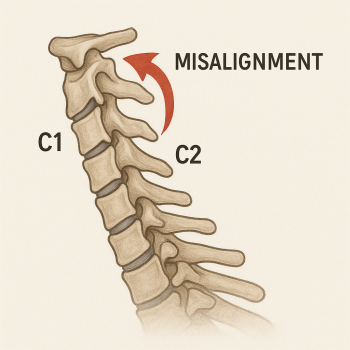
Understanding Occipital Neuralgia and What Triggers It
There are many different types of headaches, and at times it can be difficult to determine what type of headache you are experiencing. This can lead to delayed or inappropriate treatment, frustration, anxiety, and increased disability over time. Occipital neuralgia is a distinct type of headache and has characteristics that are identifiable. If you have occipital neuralgia, there are conservative treatment options available to you and hope that you will find lasting relief.
Occipital neuralgia is a term that describes nerve pain in the distribution of the nerves of the upper neck and lower skull. It is very common to experience the following symptoms with occipital neuralgia headaches:
- Neck pain
- Piercing pain in the back of the head
- Pain behind the eyes
- Electric shock like pain in the scalp, forehead, or back of the head/neck
- Ear pain
- Light sensitivity in the eyes
- …and more.
These symptoms often begin in the upper cervical spine (also known as the craniocervical junction) and extend up to the head. Typically these symptoms will be experienced on one side of the head and neck.
Occipital neuralgia is triggered by nerve irritation in the upper neck that involves the greater and lesser occipital nerves. These small nerve fibers travel through the bones and muscles of the upper neck to supply structures in the neck, head, and scalp. If they become entrapped, pinched, or irritated along their course occipital neuralgia is likely to result.
How to Interpret Occipital Neuralgia Symptoms
Since the symptoms of occipital neuralgia can mimic other conditions, it can be difficult to identify the cause of your symptoms.
The following symptoms may be signs of a more serious condition such as stroke:
- Slurring of your words
- Disorientation
- Double vision
- Drop attacks
- Facial drooping or numbness
More commonly, people experiencing occipital neuralgia will misinterpret their symptoms as a common migraine or tension type headache. While there may be similarities, it is important to consider the following factors with occipital neuralgia.
- Occipital neuralgia is typically one sided
- It usually begins with pain in the upper neck and extends up to the head
- The symptoms are related to the structures supplied by the greater and lesser occipital nerves including the upper neck, muscles of the scalp, sensation on the back of the head, ears, etc.
If these symptoms describe your experience, you may be suffering with occipital neuralgia. A typical medication diagnosis of occipital neuralgia is confirmed when injections to numb the occipital nerves results in a decrease in symptoms.
What Can Cause Occipital Neuralgia?
There are a variety of things that can contribute to the onset of occipital neuralgia symptoms. The common thread among these causes is the relationship between the structures of the upper neck and the greater and lesser occipital nerves. Irritation of these nerves can be caused by muscle spasms of the suboccipital nerves, degenerative joint disease of the upper cervical spine, and faulty alignment and mechanics of the joints of the upper neck.
Upper cervical subluxation is a condition involving misalignment of the upper neck joints and nerve irritation. This is commonly underlying occipital neuralgia and many individuals find lasting relief by addressing this underlying structural issue. Trauma to the head and neck can cause the alignment of the bones in the upper neck to become compromised leading to poor joint movements and nerve irritation. This can be caused by circumstances such as:
- Car accidents/whiplash
- Sports injuries
- Concussions
- Slips and falls
- Jarring of the head and neck
Many patients with occipital neuralgia have a history of one or more of these traumas that have accumulated over the years. These injuries are often silent at first and show no overt signs or symptoms. However, over time the wear and tear associated with upper cervical subluxation begins to increase eventually leading to the onset of secondary conditions such as occipital neuralgia.
What To Do About Occipital Neuralgia?
Typical medical procedures for occipital neuralgia are focused on symptom management rather than cause correction. Occipital nerve injections are a common treatment. These procedures use a needle to inject Botox directly into the nerves to attempt to relieve the pain. While this may provide temporary relief, many individuals need repeat injections over time.
If the underlying structural issues that are irritation the nerves are left uncorrected, attempts at symptom alleviation will be short-lived at best. Many patients have discovered that treating the alignment of the upper cervical spine provides lasting relief naturally. There are chiropractic doctors throughout the world who are trained to precisely and safely correct upper cervical subluxation without twisting, popping, or cracking the neck.
Most Common Reasons Adults Get Occipital Neuralgia
Many adults suffering with occipital neuralgia have a history of whiplash in the previous 10-15 years. This is often the “first domino” in a series of events that displaced the alignment of the upper neck. The reflexive muscle spasm in the upper neck can compress and irritate the greater and lesser occipital nerves producing the symptoms of occipital neuralgia.
Most Common Reasons Children Get Occipital Neuralgia
It is less common for pediatric patients to experience occipital neuralgia. However, children who are experiencing the symptoms of occipital neuralgia may be dismissed as “overreacting” when describing the severity of their symptoms. This leads to delayed treatment or misdiagnosed conditions.
Upper cervical subluxation may occur in children as well and is not an age-related condition. History of a traumatic birth process including vacuum or forceps extraction, sports injuries, concussion, or blows to the head may predispose some children to upper cervical subluxation and subsequently occipital neuralgia. It is important to understand what risk factors your child may have if they are complaining of symptoms related to the upper neck and occipital nerves.
Chiropractic Diagnosis for Occipital Neuralgia
When patients present to an upper cervical chiropractor with occipital neuralgia symptoms, a series of diagnostic tests will be performed to identify the cause of their problem. Generally speaking these tests will measure the structural integrity of the upper neck and the performance of the nervous system. The relationship between the alignment of the upper neck and the nerves of the upper neck is well established, and nerve irritation in this region of the spine warrants a structural evaluation.
Typical testing procedures include:
- Imaging – x-rays, MRI, Cone Beam CT
- Paraspinal Thermography
- Postural Evaluation
- Balance/coordination testing
- Spinal palpation
- Muscle testing
Chiropractic Treatment for Occipital Neuralgia
All the diagnostic testing performed provides the blueprint for correcting the alignment of the upper neck to relieve the irritation of the greater and lesser occipital nerves. Upper cervical chiropractors focus specifically on this area of the spine and have advanced adjusting procedures to ensure lasting relief without twisting, popping, or cracking the neck or back.
Depending on the severity of your condition, a customized treatment plan will be developed to improve on your spinal integrity, nerve system performance, and overall quality of life.
If you or a loved one are suffering with the negative effects of occipital neuralgia, upper cervical chiropractic may provide the lasting relief that you’re looking for. Simply request a complimentary consultation with a Blair Upper Cervical Chiropractor to learn more about your treatment options.






Leave a comment